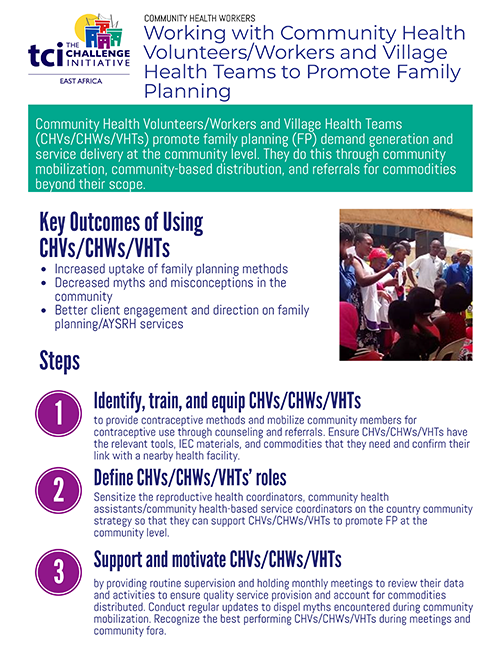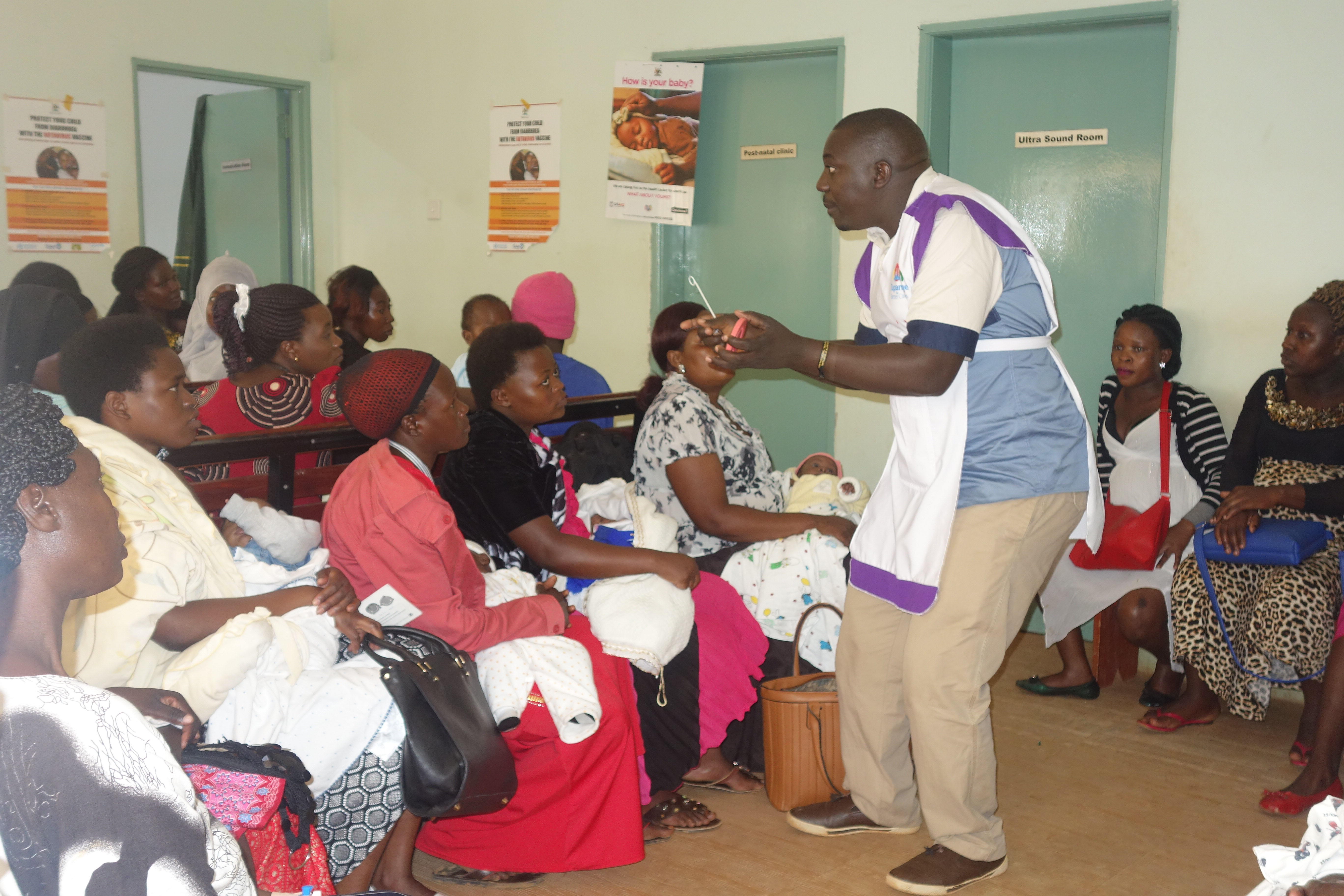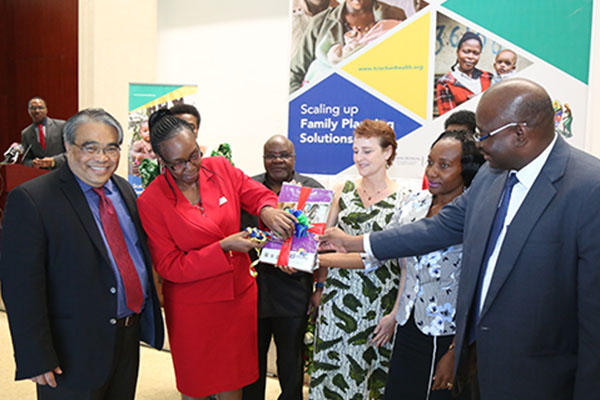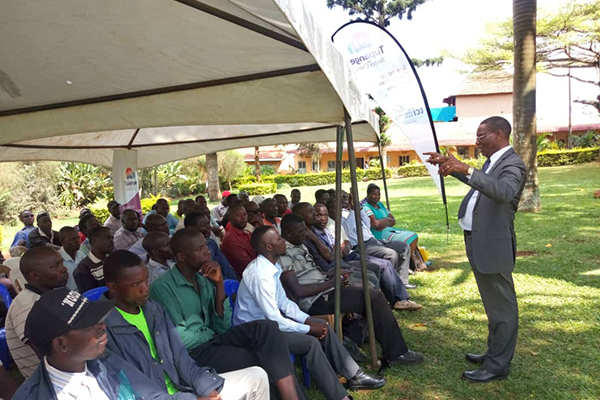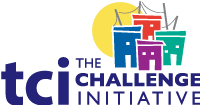East Africa Toolkit: Demand Creation
- Home
- Help and Support
- Close
- Toolkits
- Global Toolkit
- AYSRH Toolkit
- Hub Toolkits
- Core High-Impact Practices
- Gender Essentials Mini Course
- Close
- Resource Collection
- Community of Practice
- Coaching
- Log In/Register
- My Profile
- English
Working with Community Health Volunteers / Workers and Village Health Teams to Promote Family Planning
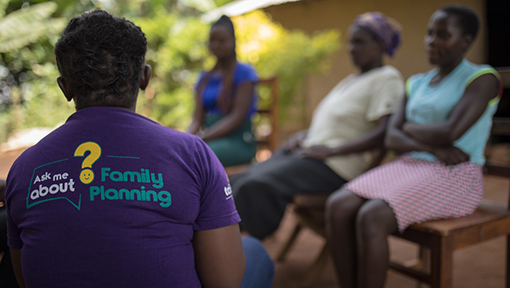
A community health volunteer during a household visit to mobilize clients for FP/AY services in Vihiga County, Kenya.
This approach provides guidance on how to engage Community Health Volunteers/Workers and Village Health Teams (CHVs/CHWs/VHTs) in promote family planning (FP) demand generation and service delivery at the community level. It provides information related to:
- Ministry of Health (MOH) guidelines on CHVs/CHWs/VHTs selection criteria and formation of functional community units
- Training CHVs/CHWs/VHTs in community-based FP using country-specific guidelines and training packages/manuals
- Providing the CHVs/CHWs/VHTs with relevant tools and resources to facilitate FP service delivery and promotion at the community level
- Linking CHVs/CHWs/VHTs to health facilities for commodities, supplies and referrals for services beyond their scope
- Strengthening community-based distribution of FP methods, counseling, effective referrals to health facilities and client mobilization during specific community campaigns
- Ensuring supervision of CHVs/CHWs/VHTs to ensure provision of quality FP services in the community
- Monitoring FP uptake data among others from CHVs/CHWs/VHTs
Why Is It Important to Work with CHVs/CHWs/VHTs to Promote Contraception and Family Planning Services? Because CHVs/CHWs/VHTs:
- Are the first level of health information and service delivery.
- Are a credible and trusted source of health information and contraceptive services within their communities.
- Are recognized as primary health caregivers by the Ministry of Health (MoH) for the provision of health services at community level.
- Have existing capacity and experience offering health information and selected services.
- Are linked to health facilities which can provide access to contraceptive commodities, supervision and information that can help them promote the uptake of contraceptives.
- Help decongest health facilities, leaving room for the health facility staff to offer quality long acting reversible and permanent methods, hence improving access and method mix.
- Provide FP/AYSRH information, counseling and provision of short-term FP methods through task shifting which can reduce provider workload and ultimately burnout.
- Have existing monitoring structures and reporting tools for FP that are linked to the national health management information system (HMIS) for tracking their outputs.
Evidence
TCI’s identification of and engagement with CHVs/CHWs/VHTs has yielded positive results, increasing the uptake of FP methods.
- They are effective links between the community and the health facility. Between 2018 and September 2022, a total of 336,046 effective FP referrals were distributed. Of which, 241,763 (71.9%) were completed. That is, they were able to reach the health facility for services.
- CHVs/CHWs/VHTs have been able to mobilize and reach a total of 3,851,133 women of reproductive age (WRA) with FP services and information service within the implementing cities between 2018 to 2022 September. Of which, 1,476,206 (38%) are adolescents and youth (AY) and 2,374,929 (62%) are >25.
- CHVs/CHWs/VHTs are an effective source for task shifting services. For example, between 2018 to September 2022, CHVs/CHWs/VHTs have able to distribute 325,333 oral contraceptive pills, 187,076 injectables and 13,737 emergency contraceptives (ECs).
- CHVs/CHWs/VHTs have been instrumental in mobilizing communities for services during in-reaches, outreaches, community dialogues and special day services.
Guidance: How to increase the capacity of CHWs/VHTs to promote Family Planning
For an effective SRH/contraception program, ensure representation of various groups (age, gender, physically challenged etc.) in the community during selection and orientation of CHVs/VHTs/CHWs.
The following steps are key to effective SRH/contraception promotion by CHVs/CHWs/VHTs:
Identify and train CHVs/CHWs/VHTs
- Identify the CHVs/CHWs/VHTs from beneficiary communities using the country Community Strategy Guide (Kenya/Tanzania/Uganda).
- Provide supplemental training/orientation in FP and contraception services to CHVs/CHWs/VHTs who have undergone Community Strategy training and are working closely with health facilities. TCI provides a 5-day training on family planning and gender sensitization topics and activities to equip CHVs/CHWs/VHTs with adequate knowledge and skills to conduct community-based distribution of contraceptives.
Health workers and their clients
- Sensitize the reproductive health coordinators, community health assistants (CHAs)/community health-based service coordinators on the country community strategy so that they can support CHVs/CHWs/VHTs to promote FP at the community level.
- Define CHVs/CHWs/VHTs’ roles in order to define areas of support to the health system. Their roles fall into three discreet areas.
| Mobilization | Linkage and referral | Community-based distribution |
|
|
|
Equip CHVs/CHWs/VHTs
- Provide CHVs/CHWs/VHTs with community tools, commodities, confirm link to health facility and relevant information, education and communication (IEC) materials for distribution.
Tip: Successful CHV/CHW/VHT programs are directly linked to continuous commodity availability at the community level.
Support and motivate CHVs/CHWs/VHTs
- Routinely supervise the activities of the CHVs/CHWs/VHTs and hold monthly meetings to review the data and activities for the month and plan for the coming month and ensure compliance with standards of practice and the delivery of quality FP services.
- The facility in-charge should join the CHVs/CHWs/VHTs data review meeting to ensure that commodities are accounted for, to offer updates on FP/AYSRH and get feedback from the community.
- Conduct updates during the monthly meetings to keep the CHVs/CHWs/VHTs abreast of updated FP information and to dispel myths encountered during community mobilization.
- Facility health staff should provide supportive supervision to the community level activities.
- Ensure they have adequate stock of contraceptives.
Tip: Motivate CHVs/CHWs/VHTs by:
- Offer lunch and transport during meetings, mobilization, in-reaches and outreaches.
- Recognize the best performing CHVs/VHTs/CHWs during meetings.
- Issue certificates after completion of trainings.
- Provide CHVs/CHWs/VHTs with promotional materials and supplies to support their efforts. These may include shirts, bags, caps, umbrella, IEC materials, umbrellas, t-shirts, etc.
- Offer a monthly stipend to support their day-to-day needs.
- Document their success and most significant change stories.
- Introduce CHVs/CHWs/VHTs to leaders and request them to recognize their work in community fora.
Monitor the work of CHVs/CHWs/VHTs
- Use data for continuous improvement based on information from a variety of sources (e.g., routine monitoring, field visits) and address performance issues to respond to the needs of the community.
- Compile supervision reports and submit to MOH through HMIS tools.
Useful Tips
- Recruit men and young champions as CHVs/CHWs/VHTs to increase the potential of reaching men and youth for reproductive health services.
- Engage CHVs/CHWs/VHTs during mobilization for outreaches and in-reaches and community dialogues.
- Create community demand for FP services and ensure availability of commodities and supplies.
- Provide branded materials to the CHVs/CHWs/VHTs to make them stand out in the community.
- Strengthen data capture and reporting by CHVs/CHWs/VHTs.
- Introduce selected and trained CHVs/CHWs/VHTs to community leaders for recognition.
Monitoring Processes
The efforts of CHVs/CHWs/VHTs in promoting FP should be monitored on a regular basis. Monitoring of the activities of CHVs/CHWs/VHTs takes place through monthly meetings and supportive supervision. The following tools have been used to collect monitoring data:
- Community-based distribution: Monitored through community health assistants, generated from the commodity tracking tool on monthly basis.
- Monthly meeting: Tracking referrals, number of clients reached, active and inactive CHVs/CHWs/VHTs, sharing of experiences, and addressing challenges with health team.
- Supportive supervision: The CHAs/CHBSCs provide routine monitoring of CHV/CHW/VHT activities at the community level through supportive supervision routinely and monthly/quarterly meetings, while the sub-county supervises community activities on a quarterly basis.
- Documentation of CHV/CHW/VHT efforts through CHV/CHW/VHT service delivery log tool, where CHVs/CHWs/VHTs record daily service activities at the household level, tracking the number of women of reproductive age at household through a household register.
Success Indicators
The efforts of the CHVs/CHWs/VHTs are measured through the following indicators:
- Number and percentage of clients reached through community-based distribution
- Number and percentage of CHVs/CHWs/VHTs that are active each quarter
- Percentage of effective referrals by CHVs/CHWs/VHTs
- Monthly meeting minutes with action plan
Cost
- Training costs: training materials, certificates, stationery; lunch and transport for CHVs/CHWs/VHTs for 5 days; facilitation fees; facilitators’ lunch and transport; snacks, training venue
- Promotional materials (branding purpose), caps, t-shirts, wraps, pens, key holders
- Printing of data collection, referral tools and reporting tools
- Monthly meetings cost: MoH staff, CHVs/CHWs/VHTs, snacks, venue, transport and lunch
- Supervision cost: MoH staff – lunch, transport and printing of the supervision tool
- Mobilization costs: snacks, lunch, water, megaphones and printing of IEC materials
Sustainability
- Work within local governments existing community health structures and systems
- Strengthen linkage of CHVs/CHWs/VHTs with health facilities for supervision and provision of FP commodities
- Advocate for resources and budget allocation to CHV/CHW/VHT activities
TCI APP USERS PLEASE NOTE
You will only receive CERTIFICATES by email – when earning a score above 80% – and will not be able to view or print a certificate PDF from the TCI app.
Test Your Knowledge
Earn a Certificate
Quiz Summary
0 of 5 Questions completed
Questions:
Information
You have already completed the quiz before. Hence you can not start it again.
Quiz is loading…
You must sign in or sign up to start the quiz.
You must first complete the following:
Results
Results
0 of 5 Questions answered correctly
Your time:
Time has elapsed
You have reached 0 of 0 point(s), (0)
Earned Point(s): 0 of 0, (0)
0 Essay(s) Pending (Possible Point(s): 0)
Categories
- Not categorized 0%
- 1
- 2
- 3
- 4
- 5
- Current
- Review
- Answered
- Correct
- Incorrect
-
Question 1 of 5
1. Question
Support for Community Health Workers/Village Health Teams includes:
CorrectIncorrect -
Question 2 of 5
2. Question
Efforts of CHWs/VHTs are measured monthly by:
CorrectIncorrect -
Question 3 of 5
3. Question
It is important to work with CHWs/VHTs because they are already trusted members in the community and already mandated by the Ministry of Health.
CorrectIncorrect -
Question 4 of 5
4. Question
How useful did you find the information and/or tools presented on this page? Please write your response in the box below using one of the following phrases: Very useful, Useful, Somewhat useful, Not useful.
Feel free to comment on why you made that choice.
-
This response will be awarded full points automatically, but it can be reviewed and adjusted after submission.
Grading can be reviewed and adjusted.Grading can be reviewed and adjusted. -
-
Question 5 of 5
5. Question
How do you intend to use the information reviewed and/or tools that you accessed?
-
This response will be awarded full points automatically, but it can be reviewed and adjusted after submission.
Grading can be reviewed and adjusted.Grading can be reviewed and adjusted. -
Demand Creation Approaches


